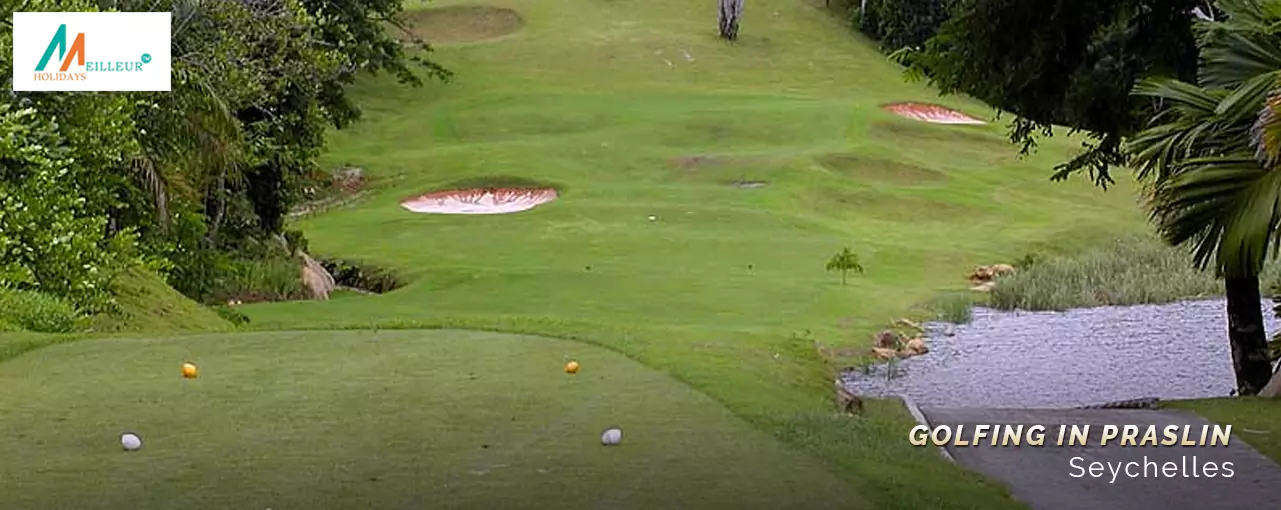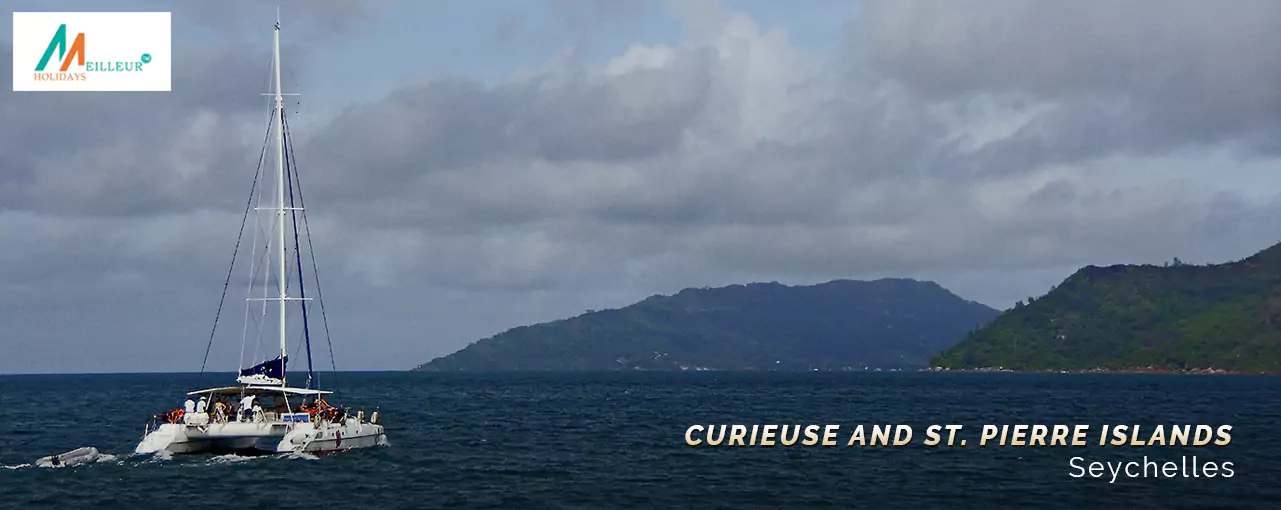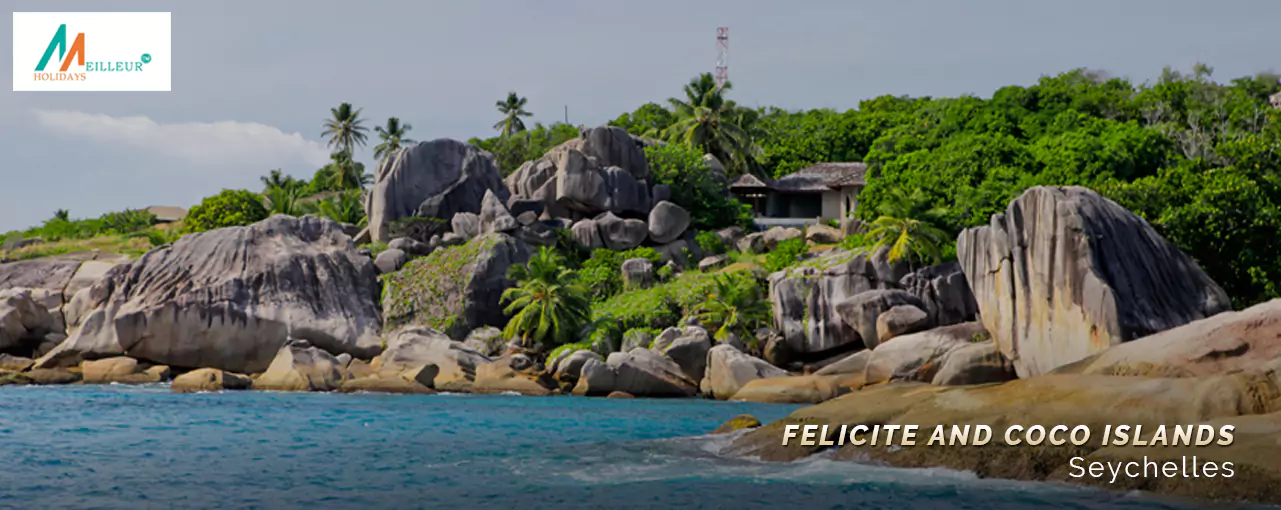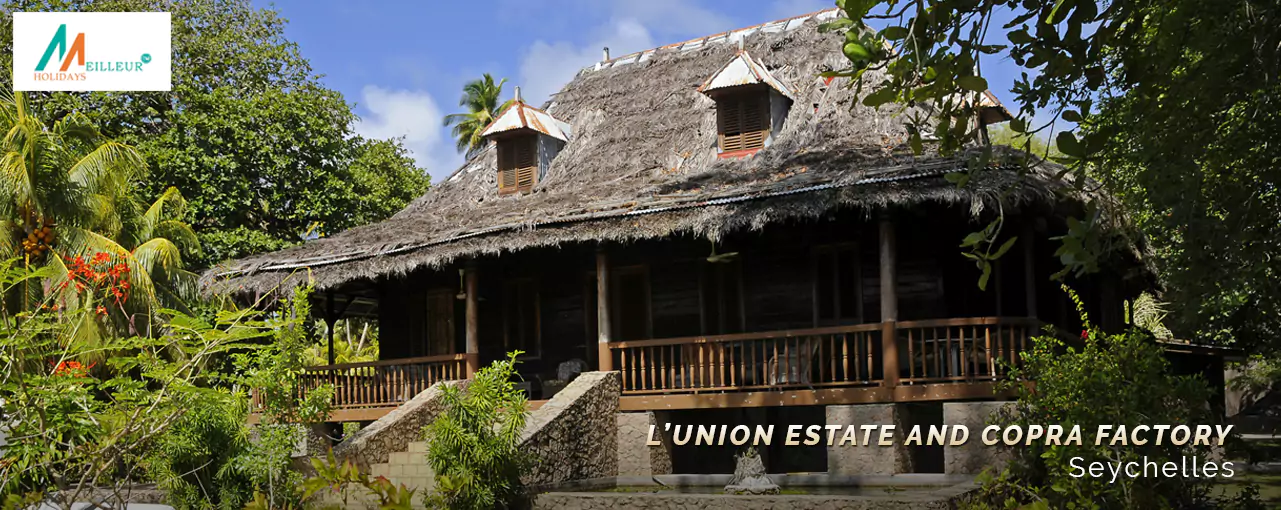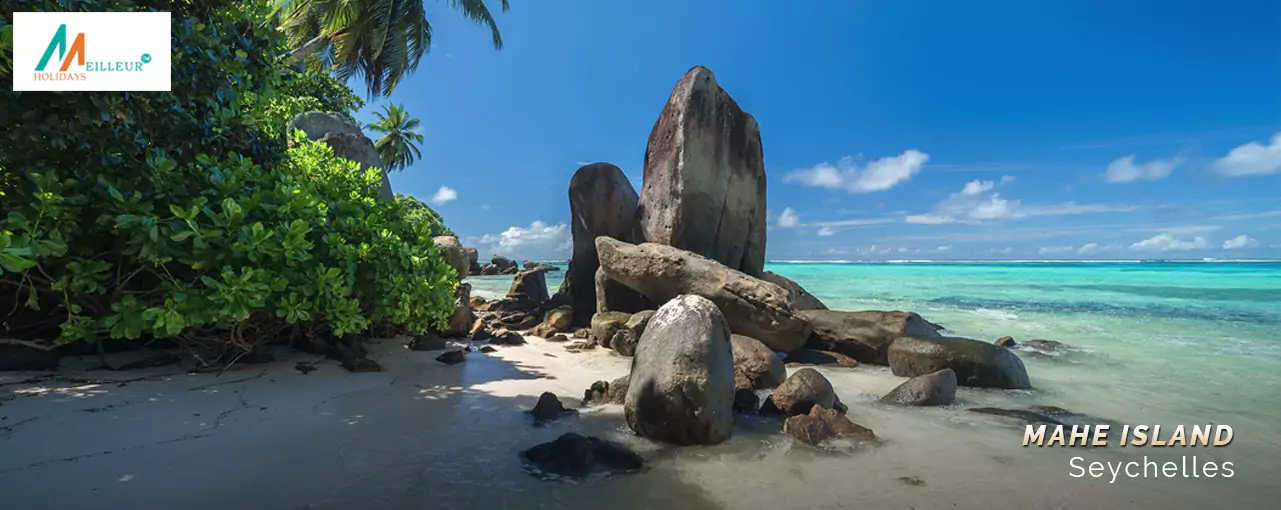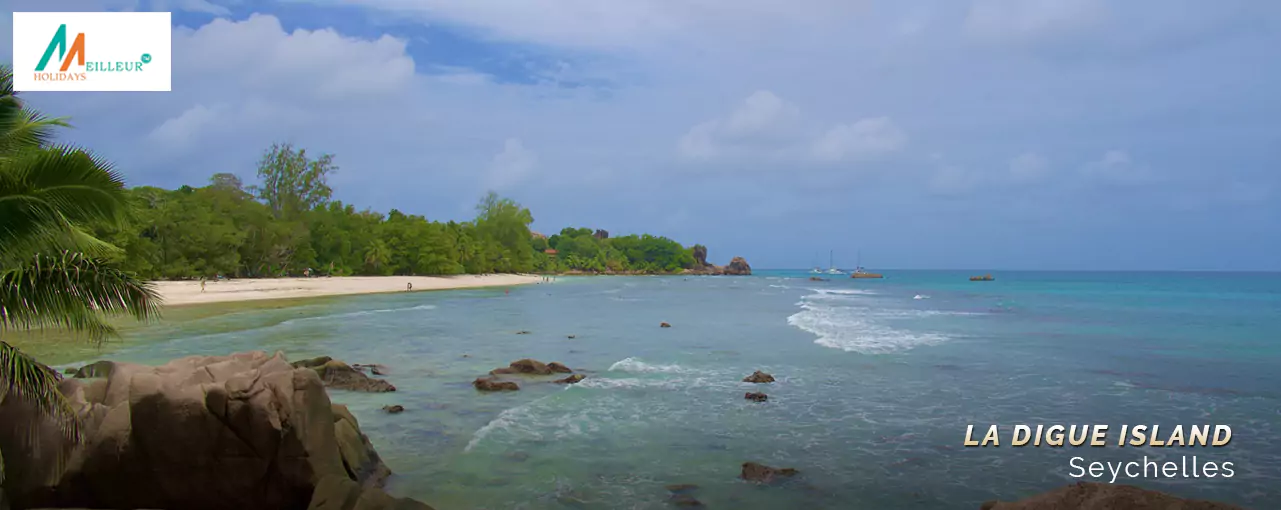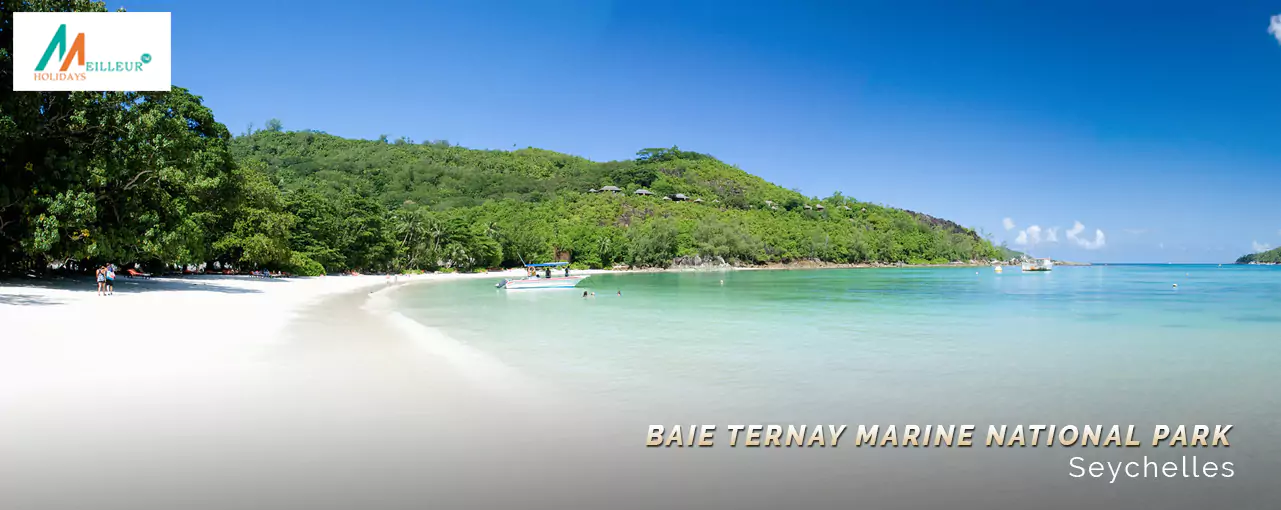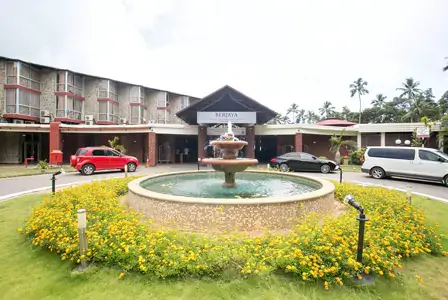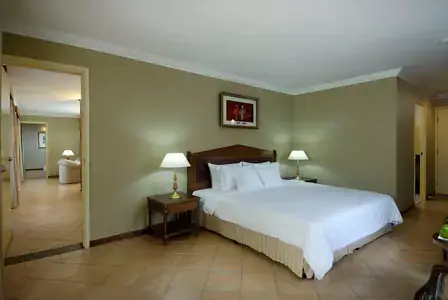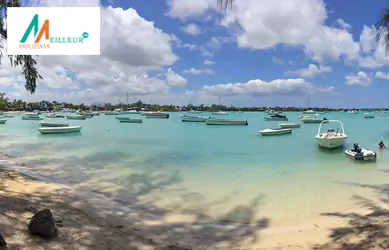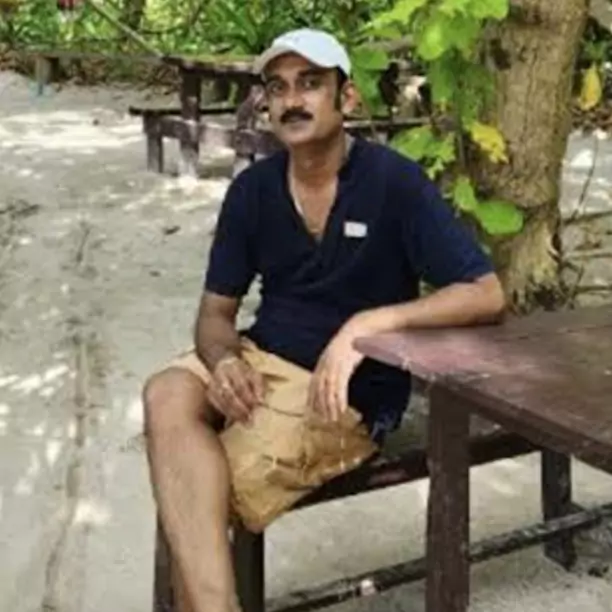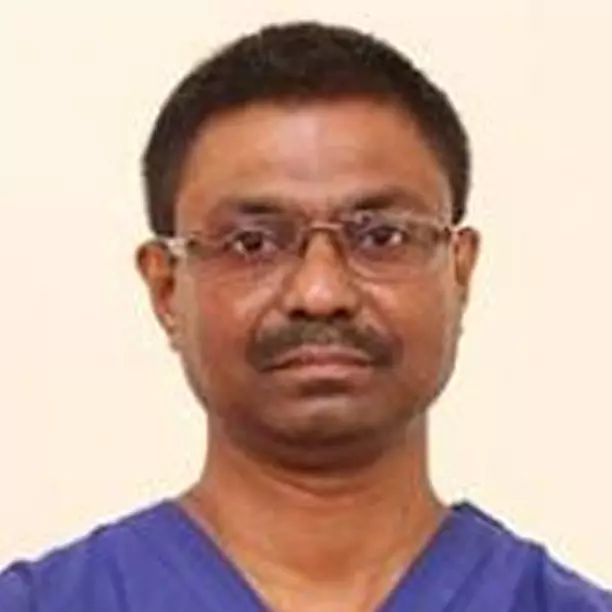Book Mauritius Tour at Best Price | For Booking Call +91-9836-11-7777
44,700/-
Per Person
Seychelles Tour
Book Seychelles Tour At Best Price
SEYCHELLES PACKAGE TOUR
Destination: 4 Nights Mahe Island.
Duration: 4 Nights / 5 Days.
Must-See Attractions in Seychelles: Mahe island tour, Reef Safari, La Digue island tour, Seychelles National Botanical Gardens, Le Jardin du Roi Spice Gardens, Baie Ternay Marine National Park, Kot Man- Ya Exotic Flower Garden, Morne Seychellois National Park, Victoria Market, Private Catamaran Customized Yacht Charters, Valee de Mai Nature Reserve, Praslin Museum, Casino Des Isles, Golfing in Praslin, Full day boat trip to Cousin, Curieuse and St. Pierre Islands, Full day boat trip to Sister, Felicite and Coco islands, Nid d’Aigle/Eagles Nest, L’Union Estate and Copra Factory, Veuve Reserve, Chateau St.Cloud.
Best time to visit: The best time to visit Seychelles are April, May, October and November. These months represent the transition times between the hot and humid northwest trade winds (from November through March) and the cooler southeast trade winds that define April through October.
Arrival and Departure Airport: Mahe International Airport.
Time Difference: India is one hour, and thirty minutes ahead of Seychelles.
Currency: Seychellois Rupee (SCR).
Language: The National languages of Seychelles are Seychellois Creole, English and French.
Duration: 4 Nights / 5 Days.
Must-See Attractions in Seychelles: Mahe island tour, Reef Safari, La Digue island tour, Seychelles National Botanical Gardens, Le Jardin du Roi Spice Gardens, Baie Ternay Marine National Park, Kot Man- Ya Exotic Flower Garden, Morne Seychellois National Park, Victoria Market, Private Catamaran Customized Yacht Charters, Valee de Mai Nature Reserve, Praslin Museum, Casino Des Isles, Golfing in Praslin, Full day boat trip to Cousin, Curieuse and St. Pierre Islands, Full day boat trip to Sister, Felicite and Coco islands, Nid d’Aigle/Eagles Nest, L’Union Estate and Copra Factory, Veuve Reserve, Chateau St.Cloud.
Best time to visit: The best time to visit Seychelles are April, May, October and November. These months represent the transition times between the hot and humid northwest trade winds (from November through March) and the cooler southeast trade winds that define April through October.
Arrival and Departure Airport: Mahe International Airport.
Time Difference: India is one hour, and thirty minutes ahead of Seychelles.
Currency: Seychellois Rupee (SCR).
Language: The National languages of Seychelles are Seychellois Creole, English and French.
Package Cost / Per Person
[Minimum 02 adults]
44,700/-
5% GST & 5% TCS Applicable
* Rates are Subject to Availability.
Meet and Greet by our representative on arrival at Port Blair Airport.
4N in Seychelles accommodation in Mahe.
Meals: 04 Breakfasts at hotel.
Return Mahe airport transfers on private basis.
Honeymoon freebies (for couples married less than 6 months).
24*7 assistance on tour.
One point of contact for entire tour.
4N in Seychelles accommodation in Mahe.
Meals: 04 Breakfasts at hotel.
Return Mahe airport transfers on private basis.
Honeymoon freebies (for couples married less than 6 months).
24*7 assistance on tour.
One point of contact for entire tour.
Airfare.
GST of 5%.
Optional Tours.
Meals not mentioned in inclusion section.
Any service not mentioned in Inclusions.
Surcharges applicable during Conventions, Special Events and Trade fairs.
Early check‐in and late check‐out are on request basis only and subject to room availability.
Cost of any other services not specifically mentioned in inclusions.
Medical and Travel Insurance.
Price fluctuation for change in the rate of exchange.
Expenses of personal nature.
GST of 5%.
Optional Tours.
Meals not mentioned in inclusion section.
Any service not mentioned in Inclusions.
Surcharges applicable during Conventions, Special Events and Trade fairs.
Early check‐in and late check‐out are on request basis only and subject to room availability.
Cost of any other services not specifically mentioned in inclusions.
Medical and Travel Insurance.
Price fluctuation for change in the rate of exchange.
Expenses of personal nature.
DOCS REQUIRE For Bookings: Photo ID proof (Driving license /Passport/Aadhar Card/Ration card/Voter card) For a Child – who does not have ID Proof – A date of birth certificate is mandatory.
The vehicle used is AC/NAC, available for point-to-point services only, and is not at disposal. Clients are requested to follow the itinerary.
Payment of 25% of Package Cost at the time of booking and balance within 7 days prior to travel date. Booking is confirmed on payment of the booking amount. Peak season / Blackout dates need 100% payment.
Cancellation Policy:
Less than 7 Days Prior to the Date of Travel: 100% of the Package Cost as a cancellation charge.
7 – 15 Days Prior to the Date of Travel: 75% of the Package Cost as a cancellation charge.
16 - 30 Days Prior to Travel: 50% of Package Cost as a cancellation charge.
More than 30 Days: Full Refund of Package Cost Excluding Processing Fees @ INR: 1000/- per head.
* Corporate/fixed group tours and tour packages on blackout days (Respective areas festival days) 100 % non-refundable, airlines as per airlines policy excluding service charges as applicable.PAYMENT TERMS: 25 % at the time of booking and balance 10 days prior travel date. All bookings are on a particular corporate non-refundable basis.
CONFIRMATION & RATE: No bookings are guaranteed without advance payment and the rate is subject to availability. INFORMATION NEEDED: Accurate Arrival and Departure timing to be informed in advance.
For More details
log in to: www.meilleurholidays.com
Email your query to: info@meilleurholidays.com
24 x 7 Sales & Support No: +91-98361177777
landline No: 033-24550052.
TERMS & CONDITIONS
Meilleurholidays reserves the right to re-arrange itineraries to suit hotel availability without changing the total number of days in each destination and compromising services.The vehicle used is AC/NAC, available for point-to-point services only, and is not at disposal. Clients are requested to follow the itinerary.
Payment of 25% of Package Cost at the time of booking and balance within 7 days prior to travel date. Booking is confirmed on payment of the booking amount. Peak season / Blackout dates need 100% payment.
Cancellation Policy:
Less than 7 Days Prior to the Date of Travel: 100% of the Package Cost as a cancellation charge.
7 – 15 Days Prior to the Date of Travel: 75% of the Package Cost as a cancellation charge.
16 - 30 Days Prior to Travel: 50% of Package Cost as a cancellation charge.
More than 30 Days: Full Refund of Package Cost Excluding Processing Fees @ INR: 1000/- per head.
* Corporate/fixed group tours and tour packages on blackout days (Respective areas festival days) 100 % non-refundable, airlines as per airlines policy excluding service charges as applicable.PAYMENT TERMS: 25 % at the time of booking and balance 10 days prior travel date. All bookings are on a particular corporate non-refundable basis.
CONFIRMATION & RATE: No bookings are guaranteed without advance payment and the rate is subject to availability. INFORMATION NEEDED: Accurate Arrival and Departure timing to be informed in advance.
For More details
log in to: www.meilleurholidays.com
Email your query to: info@meilleurholidays.com
24 x 7 Sales & Support No: +91-98361177777
landline No: 033-24550052.
Less than 10 Days Prior to Date of Travel: 100% of the Package Cost as cancellation charge.
10 – 20 Days Prior to Date of Travel: 75% of the Package Cost as cancellation charge.
21 - 30 Days Prior to Date of Travel: 50% of Package Cost as cancellation charge.
More than 30 Days Processing Fees: Full Refund of Package Cost excluding Processing Fees.
More details log-in to: www.meilleurholidays.com.
You can call at: 033 40048302// 9903598761.
Email your query at: reservations@meilleurholidays.com : info@meilleurholidays.com.
For urgency you can call:+91-983611777
10 – 20 Days Prior to Date of Travel: 75% of the Package Cost as cancellation charge.
21 - 30 Days Prior to Date of Travel: 50% of Package Cost as cancellation charge.
More than 30 Days Processing Fees: Full Refund of Package Cost excluding Processing Fees.
More details log-in to: www.meilleurholidays.com.
You can call at: 033 40048302// 9903598761.
Email your query at: reservations@meilleurholidays.com : info@meilleurholidays.com.
For urgency you can call:+91-983611777
Just pay 25% of the package cost inclusive of taxes. You will get a booking confirmation voucher within 240 minutes of the payment receipt and your booking status will be "BOOKING HOLD - CONFIRMED".
Pay the balance amount 7 days prior check in.
Please do not forget to send one email info@meilleurholidays.com marking a copy to accounts@meilleurholidays.com.
post payment mentioning your reference number. If you do not get voucher on-time you may call us at : +91 9836117777.
Pay the balance amount 7 days prior check in.
Please do not forget to send one email info@meilleurholidays.com marking a copy to accounts@meilleurholidays.com.
post payment mentioning your reference number. If you do not get voucher on-time you may call us at : +91 9836117777.
25% of the land cost & full flight fare at the time of booking, balance 15 days prior travel date.
50% of total package cost for peak period travel.
50% of total package cost for peak period travel.
HOTEL INFO
BERJAYA BEAU VALLON BAY RESORT & CASINO
Berjaya Beau Vallon Bay Resort & Casino / Similar
Day Wise Seychelles Tour Plan In Details:
A warm welcome to the beautiful island that sits serenely in the vast Indian Ocean – Seychelles. Upon arrival at Mahe International airport our representative shall assist and transfer you to your pre-booked hotel in Mahe.
The rest of the day will be at leisure. Overnight at hotel.
The rest of the day will be at leisure. Overnight at hotel.

Start your day with a delicious breakfast at hotel and as per the itinerary it is a leisure day for you today.
Alternatively you can go for optional discovery tour of Mahe island (optional cost of INR 11,500 for a couple). Operational on Monday, Thursday and Friday. t’s a great opportunity to visit famous tourist attractions of Mahe the likes of which include the Victoria Clock Tower and the colourful Sir Selwyn-Selwyn Clarke Market place.
A brief halt at the historic Mission Lodge lets you witness its ruins and, of course, a grand view of the sea coast. Later, enjoy a lip-smacking buffet lunch in a local Seychelles restaurant.
Post lunch, this Seychelles tour itinerary lets you visit herb & spice garden nearby where you can spend some peaceful moments by the side of your partner. Also visit the local craft village, get yourself some great souvenirs and be amazed by architecture and Creole culture. As the day ends, you will be transferred back to your hotel for a cozy overnight stay.
Note: Buffet lunch will only be available for the travelers who go for optional tours on this day.
Alternatively you can go for optional discovery tour of Mahe island (optional cost of INR 11,500 for a couple). Operational on Monday, Thursday and Friday. t’s a great opportunity to visit famous tourist attractions of Mahe the likes of which include the Victoria Clock Tower and the colourful Sir Selwyn-Selwyn Clarke Market place.
A brief halt at the historic Mission Lodge lets you witness its ruins and, of course, a grand view of the sea coast. Later, enjoy a lip-smacking buffet lunch in a local Seychelles restaurant.
Post lunch, this Seychelles tour itinerary lets you visit herb & spice garden nearby where you can spend some peaceful moments by the side of your partner. Also visit the local craft village, get yourself some great souvenirs and be amazed by architecture and Creole culture. As the day ends, you will be transferred back to your hotel for a cozy overnight stay.
Note: Buffet lunch will only be available for the travelers who go for optional tours on this day.

Have a scrumptious breakfast at hotel and enjoy the day at leisure on own. Go for water sports ( additional cost) or simply laze at hotel.
For couples who wish to explore more of Seychelles’ natural world, go for an optional full day reef safari inclusive of traditional buffet lunch (extra charges for the optional tour). For those who opt for reef safari, get aboard the boat and it will take you to the spot where you take a halt to feed the fish. Explore the marine world as you can enjoy swimming and let the marine enthusiast in you, come out.
Reef safari at an additional cost of INR 16,800 for a couple ( Tuesday/Thursday)
In the afternoon, you can have delectable traditional Creole-style buffet lunch and then relax for a while. Later in the day, you can choose to explore Moyenne Island or just lie down at some beautiful sandy beach alongside your partner.
Note: Buffet lunch will only be available for the travelers who go for optional tours on this day.
As the dusk falls, a cozy overnight stay awaits you at the hotel.
For couples who wish to explore more of Seychelles’ natural world, go for an optional full day reef safari inclusive of traditional buffet lunch (extra charges for the optional tour). For those who opt for reef safari, get aboard the boat and it will take you to the spot where you take a halt to feed the fish. Explore the marine world as you can enjoy swimming and let the marine enthusiast in you, come out.
Reef safari at an additional cost of INR 16,800 for a couple ( Tuesday/Thursday)
In the afternoon, you can have delectable traditional Creole-style buffet lunch and then relax for a while. Later in the day, you can choose to explore Moyenne Island or just lie down at some beautiful sandy beach alongside your partner.
Note: Buffet lunch will only be available for the travelers who go for optional tours on this day.
As the dusk falls, a cozy overnight stay awaits you at the hotel.

Enjoy a piping hot breakfast at hotel and enjoy the day as you please.
Spend the day at leisure relaxing inside your hotel room or just go out and explore the mesmerizing beauty of Mahe with your partner. Beaches, restaurants, casinos, gardens, water sports; there are so many things to do in and around Mahe Island that can keep you both engaged for the day.
Optional tour for the day – Full day Praslin and La Digue island tour at an additional cost of INR 32,200 for a couple.
Spend the day at leisure relaxing inside your hotel room or just go out and explore the mesmerizing beauty of Mahe with your partner. Beaches, restaurants, casinos, gardens, water sports; there are so many things to do in and around Mahe Island that can keep you both engaged for the day.
Optional tour for the day – Full day Praslin and La Digue island tour at an additional cost of INR 32,200 for a couple.

Wake up to a wholesome breakfast with your loved-one at the hotel. Post breakfast, get ready with your bags packed as this being the last day of your Seychelles honeymoon package, you will complete the checkout formalities.
A representative will help you in keeping your luggage safely at the hotel itself as you go out for some shopping in the local market of Mahe. Later in the evening, your transfers will be arranged to the international airport as it's time to fly back home with some fond memories.
A representative will help you in keeping your luggage safely at the hotel itself as you go out for some shopping in the local market of Mahe. Later in the evening, your transfers will be arranged to the international airport as it's time to fly back home with some fond memories.

IMPORTANT INFORMATION
Fresh Grilles Fish.
Octopus curry in coconut milk.
Coconut curry.
Bat curry.
Boiled Octopus.
Smoked Fish Salad.
Fish curry.
Shark chutney.
Octopus curry in coconut milk.
Coconut curry.
Bat curry.
Boiled Octopus.
Smoked Fish Salad.
Fish curry.
Shark chutney.
Breadfruit.
Caris Masala – Indian veg curry.
Sausage Rougay – Sausage based dish in rich tomato and onion sauce.
Banana with coconut milk.
Banana Vlambeh.
Caramelized Pineapple.
Fresh Fruit Salads.
Coconut chocolate.
Caris Masala – Indian veg curry.
Sausage Rougay – Sausage based dish in rich tomato and onion sauce.
Banana with coconut milk.
Banana Vlambeh.
Caramelized Pineapple.
Fresh Fruit Salads.
Coconut chocolate.
Fresh Fruits.
Baca – home brewed rum made of sugarcane.
Kalou – a fermented wine made of coconut sap with sweet and tart taste.
Seybrew – Bavarian style lager.
Ekyu – local beer.
Dark Takamaka Rum – local brew.
Coco D’Amour – tropical liquor with coconut extract.
Tea made with Lemongrass and Citronella Ginger Ale, Lemonade, Coconut water and Fresh juices.
Baca – home brewed rum made of sugarcane.
Kalou – a fermented wine made of coconut sap with sweet and tart taste.
Seybrew – Bavarian style lager.
Ekyu – local beer.
Dark Takamaka Rum – local brew.
Coco D’Amour – tropical liquor with coconut extract.
Tea made with Lemongrass and Citronella Ginger Ale, Lemonade, Coconut water and Fresh juices.
Marie Antoinette.
La Plaine St Adre.
La Plaine St Adre.
La Scala.
Bravo.
Bravo.
Saffron Restaurant.
Bonbon Plume.
Bonbon Plume.
Coconut Shell Artifacts.
Vanilla Pods.
Seybrew and Takamaka Rum.
Vanilla Pods.
Seybrew and Takamaka Rum.
Shark Chutney.
Gallery Art Collection.
Victoria Market – Clothes shopping in Seychelles.
Gallery Art Collection.
Victoria Market – Clothes shopping in Seychelles.
Black Pearl.
Local Souvenirs.
Local Souvenirs.
Kayaking.
Scuba Diving.
Scuba Diving.
Bottom Fishing.
Sunset Boat Trip.
Sunset Boat Trip.
Big Game Fishing.
Parasailing.
Parasailing.
Cycling around La Digue.
Whale Shark and Dolphin Watching by Boat.
Whale Shark and Dolphin Watching by Boat.
Seychelles is over 99% water ( with a marine area of 400,000 km) and the landmass constitutes only 0.03%. Majority of the population lives in Mahe, Praslin and La Digue islands.
The Seychelles archipelago was first discovered by Portuguese explorer Vasco Da Gama.
Seychelles is the smallest sovereign country in all of Africa and Victoria, the capital city of this island nation is one of the smallest capitals in the world.
The Seychelles is the only mid-ocean granite islands in the world. Their spectacular natural beauty features the most stunning beaches in the world’s set against the dramatic granite formations.
(b) National bird is Black Parrot.
(c) National Tree is Coco de mar (sea coconut).
(d) National Flower is Tropicbird Orchid.
Aldabra is the world’s second-largest coral atoll.
To ensure conservation of Seychelles unique biodiversity, about 47.06% of its landmass, almost half of the country is protected by government law.
The 'Bird Island' in Seychelles is home to ‘Esmeralda’ the heaviest land tortoise alive in the world. It weighs 304 kg.
Sea coconut (Coco de mar) is the heaviest nut found in the world.
The 'Curieuse Island' an uninhabited bio-reserve has red color soil giving it the nickname 'Red Island'.
Visitors can view flying mammals like giant fruit bats ( flying foxes) cruising above the forest at sunset at the remote island 'Silhouette island'.
Seychelles is one of the best diving destinations in the world.
Seychelles is home to the largest 'Land Crab – The Coconut Crab' found mostly on Aldabra Coral a toll.
Seychellois society is matriarchal where women play a dominate role in the household.
The Seychelles cuisine has been influenced by French, Indian, Chinese and African cuisines.
The Seychelles archipelago was first discovered by Portuguese explorer Vasco Da Gama.
Seychelles is the smallest sovereign country in all of Africa and Victoria, the capital city of this island nation is one of the smallest capitals in the world.
The Seychelles is the only mid-ocean granite islands in the world. Their spectacular natural beauty features the most stunning beaches in the world’s set against the dramatic granite formations.
In the Seychelles
(a) National animal is the Giant Tortoise.(b) National bird is Black Parrot.
(c) National Tree is Coco de mar (sea coconut).
(d) National Flower is Tropicbird Orchid.
Aldabra is the world’s second-largest coral atoll.
To ensure conservation of Seychelles unique biodiversity, about 47.06% of its landmass, almost half of the country is protected by government law.
The 'Bird Island' in Seychelles is home to ‘Esmeralda’ the heaviest land tortoise alive in the world. It weighs 304 kg.
Sea coconut (Coco de mar) is the heaviest nut found in the world.
The 'Curieuse Island' an uninhabited bio-reserve has red color soil giving it the nickname 'Red Island'.
Visitors can view flying mammals like giant fruit bats ( flying foxes) cruising above the forest at sunset at the remote island 'Silhouette island'.
Seychelles is one of the best diving destinations in the world.
Seychelles is home to the largest 'Land Crab – The Coconut Crab' found mostly on Aldabra Coral a toll.
Seychellois society is matriarchal where women play a dominate role in the household.
The Seychelles cuisine has been influenced by French, Indian, Chinese and African cuisines.
Millions of years ago when India broke away from the Gondwanaland supercontinent beginning its long drift, it left behind granite formations, a cluster of more than 100 islands far away from the nearest main island at the remote spots on the planet.
The islands which we now call Seychelles were left to evolve in complete isolation until the first French settlers came in the 18 th century. The first point that came in the settler’s mind that, Seychelles can be one such holidaying unspoilt, stunning, another world’s beauty.
The island nation of Seychelles is a destination of a lifetime with its surreal natural beauty, warm tropical climate, a vast variety of indigenous flora and fauna, lumbering tortoises, powder white sand beaches fringed by turquoise waters- a paradise on earth.
Seychelles is 455 sqkm and is composed of two main island groups – The Inner Islands or the Mahe Group, consisting of over 40 mountainous, granitic islands. The inner islands comprise of 244kms or 54% of the land area of Seychelles and 98% of the country’s population lives on them. Islands like Mahe, Praslin, La Digue are home to country’s major hotel resorts. The highest point in Seychelles, Mount Seychellois (905m) is also located within this mountainous island group.
The second islands group known as “ Outer Seychelles” is a collective term for those islands of the Seychelles that are not on the shallow bnks of Seychelles and are classified into five groups namely ‘Southern Coral Group’, Amirante Islands, Alphonse group, Aldabra Group, and Farquhar group consisting of more than 70 outer, flat, coralline islands. These are mostly uninhabited.
MAHE – THE ISLAND OF ABUNDANCE
Accessibility – Land transfers from Seychelles International Airport for hotels within Mahe. For inter-island travel there are domestic flights, helicopter services, private boat transfers and ferry services.
Best beaches in Mahe
Anse Royale – located south of Mahe, one of the most popular beaches with beautiful Scenery, its proximity to hotels and offers a variety of activities.
Beau Vallon – A firm favourite with local visitors, stunning sandy surface and beautiful atmosphere.
Port Launay North Beach – Incredibly beautiful beach.
Anse a La Mouche – located in south west with flat, calm shallow water, beautiful scenery and wonderful relaxing atmosphere.
Anse Louis – located in west of Mahe , a beautiful sheltered bay is a great location for surfers.
PRASLIN – ISLAND OF PALMS
Accessibility – Air Seychelles domestic flights, helicopter and ferry services. Praslin is the second largest island of the Seychelles.
Best beaches in Praslin
Anse Lazio – Best beach on Praslin island.
Anse Georgette – Ideal for sunbathers, lovebirds seeking alone time, for swimming,snorkeling, surfing, stunning views and watching breathtaking views of sunset.
Cote d’Or – Family friendly and an ideal place to relax and unwind. Snorkeling and scuba are good options here and watching the sun set a pleasure!
Anse Boudin – Located in northeast coast of Praslin. Offers beautiful scenery and is good for swimming, snorkeling and fishing.
Anse Government – Attractive bay on the northern coast of Praslin near popular hotel L'Archipel.
LA DIGUE – THE DREAM ISLAND
Accessibility – Domestic flights, private helicopter and ferry transfers from Mahe to La Digue.
What to Expect
Charming and serene, it is the smallest of the three main inhabited islands.
Best beaches in La Digue
Anse Source D'Argent – Shallow and calm azure blue waters of the Indian Ocean.
Grand Anse – Tropical landscape, powdery white sandy beaches, tall palm trees and crystal-clear water.
Anse Cocos – Untouched nature, its charm lies in its remoteness and the solitude it offers.
Anse Marron – Stunning natural pool and beach combo with blindingly white sand and granite formations which shelter seawater pools making it ideal for swimming.
Anse La Renunion – Natural shade and beautiful.
Always wear a Mask if your visiting the public place.
Owing to the zigzagging hilly roads, motion sickness is another challenge. Keep the necessary medication along with you.
Carry back all non-degradable litter such as empty bottles, tins, plastic bags etc. These must not litter the environment or be buried. They must be disposed in municipal dustbins only.
Keep all pollutants away from streams and lakes.
Do respect people's privacy while taking photographs. Ask for prior permission before taking a photograph. Dress modestly. Be aware of the customs and manners and culture of the local people.
It is customary to leave a donation at a monastery and to circle shrines in clockwise direction.
Avoid loud music and noise.
Always keep your Identity Card / Passport Copies to avoid hasslement in hotels.
Do Use dustbin in public places as you are also responsible for clean environment.
Don't take a lot of cash with you, there are many ATM's of almost all major banks in the major towns of the region.
Do not encourage beggars and always beware of strangers.
Observe the sanctity of holy sites, temples and local cultures.
In case temporary toilets are set-up near campsites, after defecation, cover with mud or sand. Make sure that the spot is at least 30 meters away from the water source.
Vegetation is fragile; follow designated trails.
While traveling to high Hills always carry Camera, Goggles, Sun screen lotion and Sports Shoes in case you like nature walks (Binoculars are optional).
If you’re planning to visit the market please visit in between 1000am- 1900pm only as most of the place will get closed by 2000hrs –
Make sure you are well aware of Restricted Area Permit and Protected Area Permit before visiting Sikkim.
Drink sufficient amount of water to avoid dehydration while trekking.
Remember to register at the forest or wildlife check posts before entering for your safety.
While hiking, wear comfortable shoes since the trails can get rough at places.
Always travel with a local guide ( Trekking trip ). Look for genuine travel guides who knows everything about the state.
While trekking, always follow the designed path, do not interrupt the fragile vegetation.
Applying of sunscreen is a necessity to avoid sunburns and always carry sunglasses and hats while touring.
Owing to the zigzagging hilly roads, motion sickness is another challenge. Keep the necessary medication along with you.
Carry back all non-degradable litter such as empty bottles, tins, plastic bags etc. These must not litter the environment or be buried. They must be disposed in municipal dustbins only.
Keep all pollutants away from streams and lakes.
Do respect people's privacy while taking photographs. Ask for prior permission before taking a photograph. Dress modestly. Be aware of the customs and manners and culture of the local people.
It is customary to leave a donation at a monastery and to circle shrines in clockwise direction.
Avoid loud music and noise.
Always keep your Identity Card / Passport Copies to avoid hasslement in hotels.
Do Use dustbin in public places as you are also responsible for clean environment.
Don't take a lot of cash with you, there are many ATM's of almost all major banks in the major towns of the region.
Do not encourage beggars and always beware of strangers.
Observe the sanctity of holy sites, temples and local cultures.
In case temporary toilets are set-up near campsites, after defecation, cover with mud or sand. Make sure that the spot is at least 30 meters away from the water source.
Vegetation is fragile; follow designated trails.
While traveling to high Hills always carry Camera, Goggles, Sun screen lotion and Sports Shoes in case you like nature walks (Binoculars are optional).
If you’re planning to visit the market please visit in between 1000am- 1900pm only as most of the place will get closed by 2000hrs –
Make sure you are well aware of Restricted Area Permit and Protected Area Permit before visiting Sikkim.
Drink sufficient amount of water to avoid dehydration while trekking.
Remember to register at the forest or wildlife check posts before entering for your safety.
While hiking, wear comfortable shoes since the trails can get rough at places.
Always travel with a local guide ( Trekking trip ). Look for genuine travel guides who knows everything about the state.
While trekking, always follow the designed path, do not interrupt the fragile vegetation.
Applying of sunscreen is a necessity to avoid sunburns and always carry sunglasses and hats while touring.
Don’t disturb wildlife or its habitat.
Don't play loud music inside the forested areas.
Don’t buy endangered species or antiques.
Don’t smoke, drink alcohol or talk loudly near sacred places.
Don’t pluck plants or flowers.
Don’t use Plastic Bags or Plastic Bottles in the forest area as plastic does NOT decay itself & harms the natural environment. If you do use plastic kindly don't throw in the forest and carry back.
Don’t throw cigarette buts on leaf litter as they are an important cause for forest fires
Do not leave any non-biodegradable items.
Do not scribble on trees, rocks and buildings.
Do not destroy any type of vegetation or plants during your visit here.
Do not take away flora and fauna in the forms of cuttings, seeds or roots. It is illegal, especially in the Himalayas. The environment is really delicate in this region and the bio-diversity of the region has to be protected at all costs.
Do not use pollutants such as detergent, in streams or springs while washing and bathing.
Do not use wood as fuel to cook food at the campsite.
Do not consume aerated drinks, alcohol, drugs or any other intoxicant and throw bottles in the wild.
Do not tempt the locals, especially children by offering them foodstuff or sweets. Respect local traditions.
Polythene and plastics are non biodegradable and unhealthy for the environment and must not be used and littered.
Avoid entering the temple premises if you are on your menstrual cycle. It is followed by all locals and expected from tourists as well.
The left hand is considered to be somewhat polluted. Avoid handing money or tapping anyone with the left hand.
In hills - locals are conservative and do not appreciate the public display of affection. Keep a check on your body language and choice of words as well.
It is not allowed to swim in the rivers, lakes or glaciers in the protected areas.
Buying or dealing in products made from the skins of endangered species or of any another animal is strictly prohibited. Buying and selling of antiques are also illegal as per the government norms in Sikkim.
Don't play loud music inside the forested areas.
Don’t buy endangered species or antiques.
Don’t smoke, drink alcohol or talk loudly near sacred places.
Don’t pluck plants or flowers.
Don’t use Plastic Bags or Plastic Bottles in the forest area as plastic does NOT decay itself & harms the natural environment. If you do use plastic kindly don't throw in the forest and carry back.
Don’t throw cigarette buts on leaf litter as they are an important cause for forest fires
Do not leave any non-biodegradable items.
Do not scribble on trees, rocks and buildings.
Do not destroy any type of vegetation or plants during your visit here.
Do not take away flora and fauna in the forms of cuttings, seeds or roots. It is illegal, especially in the Himalayas. The environment is really delicate in this region and the bio-diversity of the region has to be protected at all costs.
Do not use pollutants such as detergent, in streams or springs while washing and bathing.
Do not use wood as fuel to cook food at the campsite.
Do not consume aerated drinks, alcohol, drugs or any other intoxicant and throw bottles in the wild.
Do not tempt the locals, especially children by offering them foodstuff or sweets. Respect local traditions.
Polythene and plastics are non biodegradable and unhealthy for the environment and must not be used and littered.
Avoid entering the temple premises if you are on your menstrual cycle. It is followed by all locals and expected from tourists as well.
The left hand is considered to be somewhat polluted. Avoid handing money or tapping anyone with the left hand.
In hills - locals are conservative and do not appreciate the public display of affection. Keep a check on your body language and choice of words as well.
It is not allowed to swim in the rivers, lakes or glaciers in the protected areas.
Buying or dealing in products made from the skins of endangered species or of any another animal is strictly prohibited. Buying and selling of antiques are also illegal as per the government norms in Sikkim.
Similar Packages
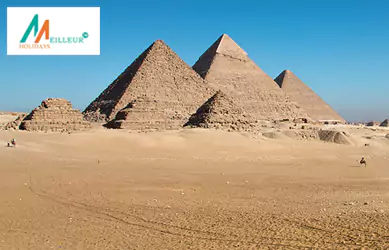
26500/-
Book Egypt Tour
Package Tour At Best Price
WE OFFER EGYPT PACKAGE TOUR AT BEST PRICE | FOR BOOKING CALL +91-9836117777
Our Client's Say
FREE VISA - NO VISA REQUIRED for tourists to travel 'THAILAND / SRILANKA / MALAYASIA'
Meilleur Holidays Quick Links
Affiliation & Membership




















